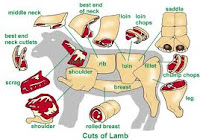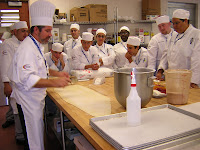MY EPIPHANY
I owe my “reincarnation” as a formally-trained cook to a beloved sorority sister, Rose G., who unwittingly served as the catalyst for my life-changing decision to switch careers and plumb the mysteries and embrace the vicissitudes of the culinary world. I am also very very lucky to have a husband and children who are my most avid fans, and who have given me their unfailing support and encouragement from the get-go.
After taking early retirement from the IMF, I spent the first couple of years coasting along (bumming around would be more apt), luxuriating in my long-awaited freedom from the grinding stress of my job, and enjoying every moment of my well-deserved reward after more than 30 years of working. But then, I would soon spend many moments worrying about what I would do with myself when the boredom from doing nothing started to set in.
I researched setting up a furniture import-export business, and made several “reconnaissance” trips to Manila and some provinces to visit factories and interview a few “movers and shakers” in the industry. In the end, I decided that it was not what I wanted to do – the idea just failed to spark any enthusiasm in me. More importantly, the financial risk was too high. This was in late 2004, and I was back to square one of rethinking my life’s direction, but I was soon flying back home to the U.S., and I would have plenty of time to think about it on the long flight home.
On the eve of my departure from Manila, Sis Rose phoned and said that, as a parting gift, she had bought tickets for us to go to a cooking demo by Chef Reggie Aspiras (a well-known chef in Manila, and my namesake) at the Bon Appetit Restaurant at Shangri-la Mall in Ortigas. I still had last-minute errands to do before my flight the next day, so it was with much hesitation that I agreed to go. I still clearly remember thinking to myself, “A cooking demo? But I’m already a good cook!” I had never been to a cooking demo, however, so I figured it wouldn’t hurt to go, and I might even have some fun.
So there I was, in a demo kitchen packed to the rafters with people who had paid through the nose (I was to find out later how expensive the tickets were) to watch Chef Reggie cook. I sat there quite enthralled by the whole scene, and fascinated to watch as Chef Reggie confidently cooked one dish after another (she made 5 dishes) while a troop of at least 8 assistants traipsed about efficiently bringing to her the prep trays of ingredients for each dish, and clearing away any mess that might get in her way. Hmmm, I could this, I thought.
As it turned out, I already knew how to cook all the 5 dishes that she made, and that was when, right there and then, my brain went into an excited spin, and I decided that this was what I wanted to do—cook and teach! But, first, I had to get my street creds.
My entire flight home was spent planning and writing down ideas of how to go about this exciting new adventure I was about to undertake. I had heard of Le Cordon Bleu in Paris, and in my online research when I got home, I was pleasantly surprised to find that there were indeed a small number of culinary schools in the U.S. licensed by Le Cordon Bleu (7 or 8, I think), and there was one in Orlando, Florida, where an army of relatives lived. And so it was that on January 9, 2005, a short two months after I had my epiphany, I went to Orientation Day for New Students at the Orlando Culinary Academy (OCA), which was to be my “home” for the next year and a half.
Little did I know what I was getting myself into.
The tuition (a king's ransom, a friend said) covered a couple of sets of uniform (chef's jackets and pants, hat, neckerchief) and--what sent our hearts to go pitter-patter--a knife kit and a good collection of kitchen tools, which came in a wheeled carry-on suitcase. We also got our textbooks--big, heavy tomes.
The rules were very strict -- each day began with us in a queue, like kindergarten kids, hands out, palms down. We got inspected for clean uniform, clean white undershirt (colors not allowed), clean hands, clean nails cut really short (no nail polish), no facial hair, no hair peeking out of your floppy hat, clean socks and shoes, no visible body piercings, and an instant-read thermometer in your sleeve pocket. Any major violation, and you were sent home for the day. Three tardies equaled one absence, and three unexcused absences meant you got kicked out for good. You got demerits for not having the proper knife or tool when needed. You got demerits for a messy workstation. And that is just to name a few.
I was 56 years old, and the oldest among my fellow students could not have been over 30. There were a couple who probably hadn't even reached 20. My own children were older than these kids! But thank goodness I was too excited to focus on that.
CULINARY SKILLS I & II
Under Chef Smith, we started with knife skills – did you know that there are at least 4 different sizes of dice, with the smallest one (brunoise) being a perfect cube measuring 1/16” x 1/16” x 1/16,” and the biggest one (large dice) measuring 3/4” x 3/4” x 3/4”? There are also at least 4 different sizes of julienne (matchstick cut), with the finest one (fine julienne) measuring 1/16” x 1/16” x 2-2 1/2” long, and the biggest one (batonnet) measuring 1/4” x 1/4” x 2- 2 1/2” long. We learned how to “tourné” a potato or carrot into a 2-inch long pointy mini-football with 7 uniform flat sides, and how to flute a mushroom cap where you decorate the cap with these uniform swirly incisions using a tiny knife. The final exams at the end included doing all the different cuts using potatoes and carrots, with the chef instructor actually using a ruler to measure your cuts!
We also learned about “mise” which is shorthand for mise en place, a French phrase which literally means “put in place,” also called prep work. Getting your mise done was to be de rigueur for any cooking activity that we would be doing. Other courses were on tools and equipment; basic cooking principles (moist heat/dry heat cooking); making stocks and “small sauces” from the “mother sauces;” how to cook vegetables, starch, proteins, soups, and eggs; recipe and menu structures; and, yes, how to "deep-clean" a kitchen (!).
SANITATION & NUTRITION
We all had a lot of fun in this course, taught by Prof. Mann who was a highly-qualified professional nutritionist, among other things. We learned about the history of food and cooking, safe kitchen procedures, the causes of food spoilage and food-borne illnesses, and the principles of nutrition and the relationship of nutrition to health. Prof. Mann conducted our final exams in a Jeopardy-like game – how cool is that?
[More to come]MEAT FABRICATION
I don’t know why, but I cannot find a single photo of this class, which is a pity because it’s one of the most engaging among the courses.
They say that if you’re squeamish about butchering an animal or killing a lobster, you cannot be a chef. Very very true, and I found that out very quickly. Luckily, when I was growing up back in the Philippines, we had a large chicken coop in the backyard, which supplied the chickens and eggs for the table. For some reason, I became one of the designated chicken butchers whenever the lunch or dinner menu called for chicken—so, I had a lot of practice for this class. My siblings and I also enjoyed collecting the still-warm eggs for our breakfast.
In this class Chef Barth showed us how to “fabricate” (break down into standardized primal and sub-primal cuts) carcasses of a cow, a baby cow (for veal), pig, baby lamb, poultry, rabbit , a wild boar loin, an ostrich loin, frogs legs, and seafood—which included flat and round fish (filleting and skinning), shrimp (peeling and de-veining), lobster (cracking), mussels (de-bearding), oysters and clams (opening), octopus (removing the beak), and squid (removing the pen). Did you know that corned beef is made from the “point” cut of a whole beef brisket, and pastrami from the “flat” cut? [Are you getting sleepy yet?] We de-boned a fresh ham, and seasoned, barded, and tied it for roasting.
A lot of de-boning and filleting went on in this class, and we all had to take turns at the bone saw (bigger than a carpenter’s saw!) to remove the chine bone (backbone or vertebrae) from the rib or rack. We also “Frenched” racks of veal and lamb (you know, where you take a full rack and remove the meat/muscle/fat between the long rib bones, so you have the bones sticking out, all nice and smooth – see photo above).
BAKING & PASTRY, INTRO & ADVANCED
I loved these classes!! We were fortunate to have had the same chef for both classes (Chef Utera, whom we all loved). Baking is an exact science, and we measured most of the ingredients using an industrial weighing scale (absolutely no guessing or estimating here!).
In the Intro class (lots of lectures!), the first thing we learned was how to use the Baker’s Percentage formula to accurately convert recipes (this is where the weighing becomes really important). We also learned the 12 basic steps in the production of yeast goods and about dough fermentation; how to prepare different doughs using different flours to make breads (including artisan and hearth-style), rolls, flat breads, pizza, Danishes and croissants (including fillings), biscuits, muffins, quick breads, corn breads, popovers, and cookies. All that basic stuff.
The Advanced class consisted mainly of Chef Utera demo’ing a particular baked product and then letting us loose to make our own – such fun! Here’s a quick list of what we learned or made: pie dough, pie shells, fruit tarts, pate brisée dough, frangipane, pastry cream filling, éclairs, profiteroles, swan pastries, tarts and tartlets, all kinds of cakes (simple and layered), icings and glazes, cake decorating, using a pastry bag and a pastry cone, chocolate icing and filigrees, shell boarders, rosettes, roses, stenciled cookies, Florentines, puddings, custards, mousses, soufflés, ice cream, candy-making, marzipan, sugar techniques.
We baked so much bread and pastries on a daily basis for six straight weeks that I have no doubt the whole class must have gained a pound or two (or more) during the process. For sure, my relatives were only too happy to be at the receiving end of the fruits of my labor.






















No comments:
Post a Comment